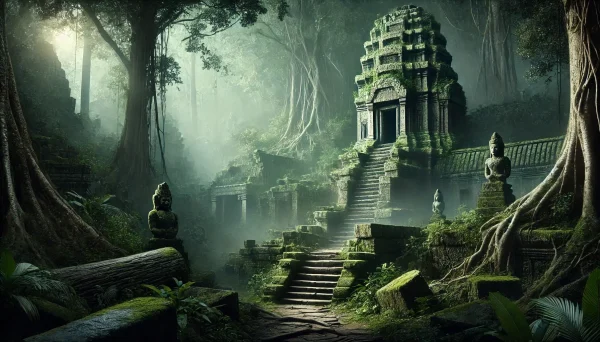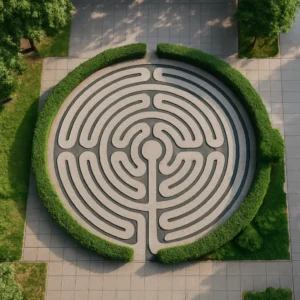Across the globe, hidden beneath dense jungles, buried by sand, or lying submerged beneath the sea, are the remnants of cities that once thrived—and then vanished. Some were abandoned due to war, environmental changes, or unknown catastrophes. Others faded gradually, lost to time and forgotten by history. While a few have been partially uncovered by archaeologists, many remain cloaked in mystery, holding secrets waiting to be unearthed. These lost cities continue to spark the imagination, hinting at ancient civilizations more advanced, complex, or enigmatic than we ever imagined.
1. Ciudad Perdida – Colombia
Hidden deep within the Sierra Nevada mountains, Ciudad Perdida (Spanish for “Lost City”) predates Machu Picchu by at least 600 years. Believed to have been built by the Tayrona civilization around 800 CE, the city remained unknown to the modern world until its discovery in the 1970s. Accessing the site requires a multi-day trek through dense jungle, and much of the city remains buried. Spiral stone terraces, ceremonial plazas, and stairways suggest a sophisticated urban design, but little is known about the people who built it—or why it was abandoned.
2. Nan Madol – Micronesia
Often called the “Venice of the Pacific,” Nan Madol is a mysterious city built on a series of small artificial islands off the coast of Pohnpei. Constructed entirely from massive basalt stones—some weighing up to 50 tons—its exact purpose and method of construction remain unclear. Believed to have been the ceremonial and political center of the Saudeleur Dynasty between 1200 and 1600 CE, Nan Madol’s remote location and unusual design have inspired theories ranging from lost technology to ancient alien contact.
3. El Mirador – Guatemala
Deep in the Guatemalan rainforest lies El Mirador, one of the largest and oldest Mayan cities ever discovered. The city flourished as early as 600 BCE and is home to one of the world’s largest pyramids by volume: La Danta. Despite its significance, El Mirador remains largely unexcavated due to its remote location and dense jungle cover. LIDAR technology has recently revealed vast road systems and structures hidden beneath the canopy, suggesting a much more advanced civilization than previously understood.
4. Shahr-e Sukhteh – Iran
Also known as the “Burnt City,” Shahr-e Sukhteh lies in the desert of southeastern Iran and dates back over 5,000 years. Excavations have revealed evidence of advanced urban planning, including a sewage system, a women’s grave containing an artificial eye (the oldest known), and the world’s earliest known brain surgery. However, only a small portion of the site has been explored, and its sudden decline around 1800 BCE remains a mystery.
5. Derinkuyu – Turkey
Derinkuyu is an ancient underground city carved into the rock beneath Cappadocia, capable of housing up to 20,000 people. With air shafts, storage rooms, churches, and even schools, it is one of the most sophisticated subterranean settlements ever discovered. Scholars believe it may have been used as a refuge during invasions, but its true origin, date of construction, and full extent remain unclear. The deeper levels are still being explored, with some tunnels rumored to connect to other underground cities miles away.
6. Thonis-Heracleion – Egypt
Once a major port city in ancient Egypt, Thonis-Heracleion was lost to the sea for over a thousand years until its rediscovery in the early 2000s. Located near the modern-day city of Alexandria, it was a wealthy and powerful city filled with temples, sphinxes, and colossal statues. Today, the ruins lie submerged beneath the Mediterranean, with ongoing underwater excavations revealing new secrets every year. Much of the city is still buried in the seabed, protected by layers of silt and time.
7. Kalibangan – India
Part of the ancient Indus Valley Civilization, Kalibangan is known for having one of the earliest plowed agricultural fields in the world and unique fire altars. Discovered in the 20th century, only a portion of the site has been excavated, and many of its structures lie untouched. The exact reason for the city’s decline, like others in the Indus Valley, remains unknown. Some theories suggest climate change or tectonic activity may have caused the Saraswati River to dry up, leading to abandonment.
8. Ubar – Oman
Sometimes referred to as the “Atlantis of the Sands,” Ubar was a legendary trading city said to lie in the Arabian desert. Long thought to be a myth, it was rediscovered via satellite imagery in 1992, revealing ancient ruins at a site known as Shisr. Archaeologists believe it was a key stop on the frankincense trade route, but much of the site remains unexcavated. Its collapse may have been caused by the ground beneath it literally caving in.
9. Sanchi – India
While known for its impressive Buddhist stupas, the surrounding area of Sanchi is home to ruins of ancient monasteries, temples, and forgotten settlements. Though the main site has been explored, satellite imagery and new archaeological studies suggest there are many more unexplored ruins scattered around the region. These forgotten relics may hold secrets about the spread of Buddhism and the daily lives of ancient monks and pilgrims.
10. Cahokia – USA
Near present-day St. Louis, Cahokia was once the largest pre-Columbian city north of Mexico. At its peak around 1100 CE, it supported tens of thousands of people and featured massive earthen mounds, plazas, and a complex social structure. Despite its size and sophistication, much of Cahokia’s culture and history remains unknown, and excavation is still limited. The reasons for its decline remain debated—ranging from environmental stress to social upheaval.
Conclusion: Cities Still Whispering from the Shadows
These lost cities remind us how much of our past remains hidden. Beneath jungles, deserts, oceans, and modern development lie entire worlds waiting to be rediscovered. They challenge our assumptions about ancient civilizations, their knowledge, and their reach. As technology advances, more of these forgotten cities may come to light—but until then, they remain wrapped in mystery, offering tantalizing glimpses of forgotten chapters in human history.








